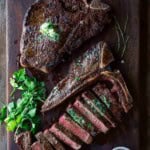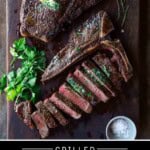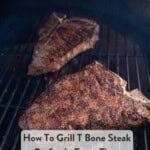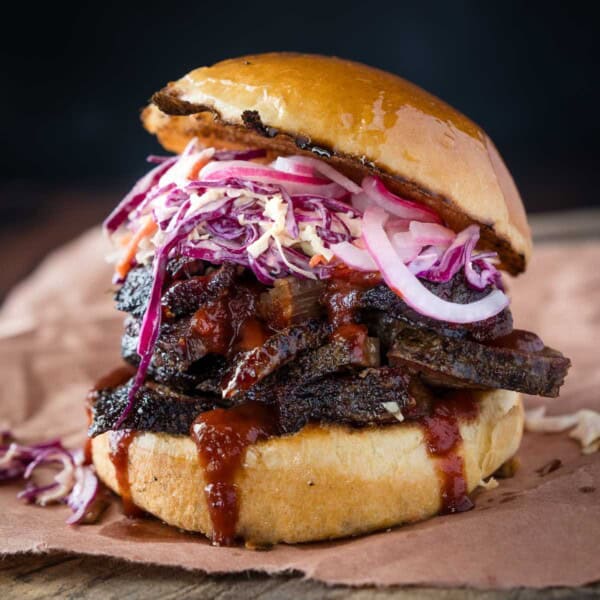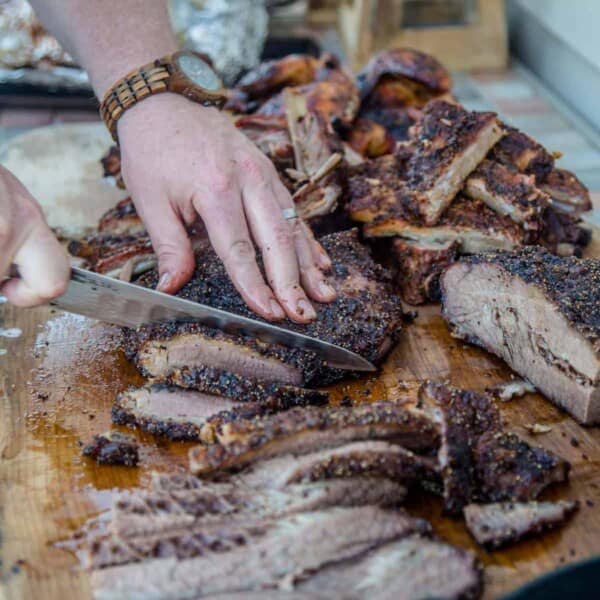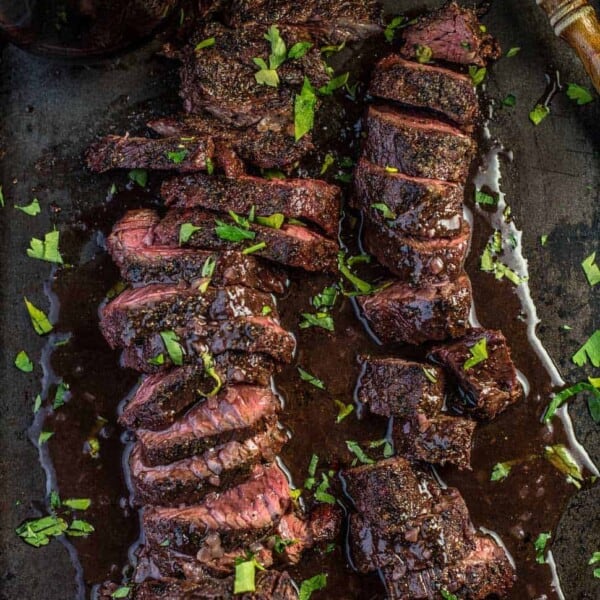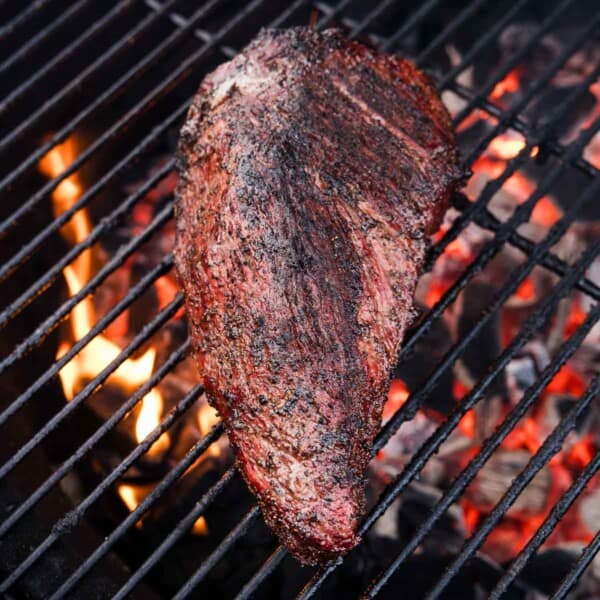This post may contain affiliate links. Read more at our disclosure policy.
Grilling a T-Bone Steak is one of the easiest and most delicious ways to enjoy this juicy, flavorful cut of beef. Whether you’re new to grilling or want to sharpen your steak game, this simple recipe will walk you through each step.
With just a few seasonings and a homemade garlic herb compound butter, you’ll turn an ordinary T-bone steak into something you’d be proud to serve at any backyard cookout.

Table of Contents
T-Bone Steak Ingredients + Substitutions
Before you fire up the grill, make sure you have everything ready. Here’s what you’ll need for the perfect T-bone steak dinner.
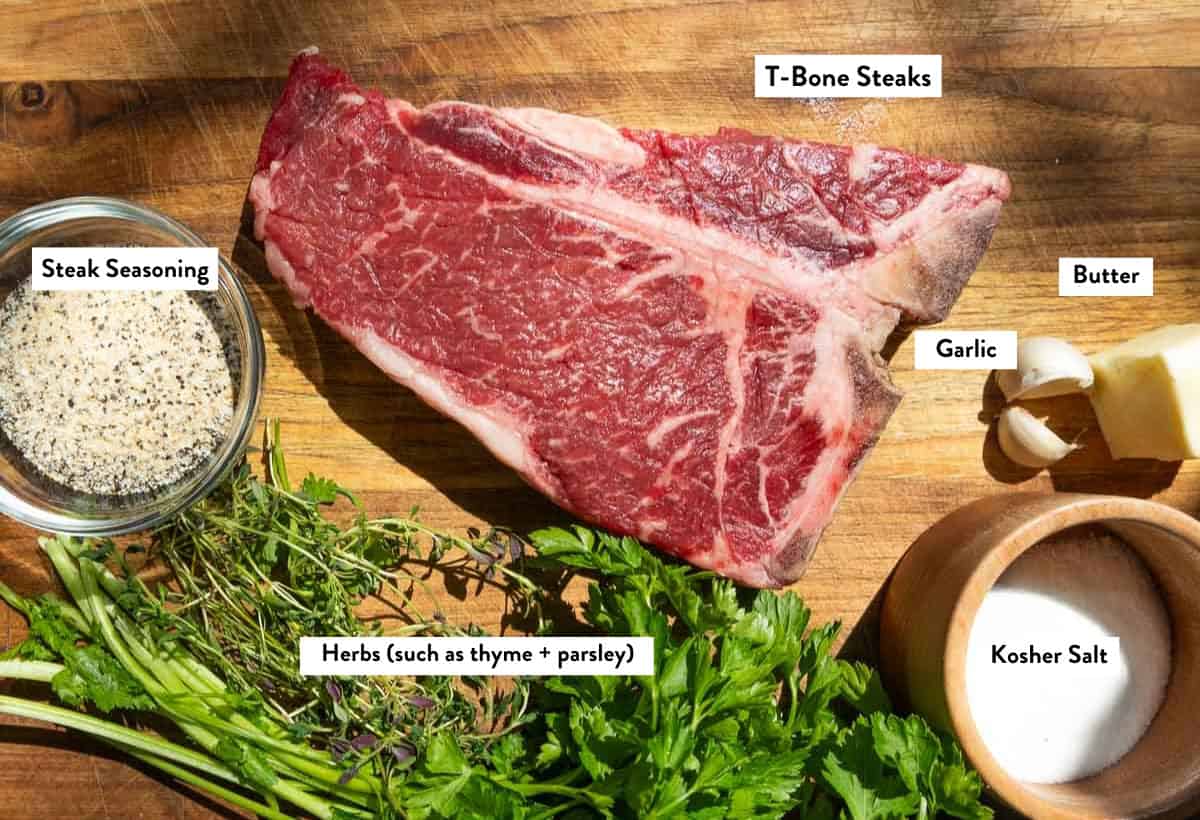
- 1 or more T-Bone Steaks (aim for at least 1.5 inches thick if you can find them) – You can also use a Porterhouse Steak, which is almost the same cut but with a larger filet.
- Kosher Salt – We do not recommend using iodized table salt with our seasoning. We use our SPG Rub. For more herbal flavors, consider using our Beef Seasoning.
- Fresh Ground Black Pepper
- Granulated Garlic
- Garlic Herb Compound Butter (see below)
Buying Tip: Buy a thick steak if you can. Call the butcher ahead of time and ask for a 1 1/2 inch thick T-Bone if possible. If all you can find is a thinner steak, then adjust the grilling times down. For more details on thinner steaks, check out our guide on how to grill thin steaks.
Seasoning
A great T-bone steak doesn’t need much to taste amazing. The key is using quality salt, pepper, and granulated garlic (or an SPG Rub). These three simple ingredients help bring out the natural flavors of the beef. Season both sides of your T-bone steak evenly, and don’t forget the edges.
Ideally, season 24 hours before grilling so a dry brine can set and add more flavor. If you don’t have that kind of time, then just add a small amount of olive oil to the outside of the steak and then add the seasoning so it sticks.
Compound Butter
While your T-bone steak is cooking, whip up the garlic herb compound butter. This butter adds rich flavor and melts beautifully over your hot steak.
- Unsalted Butter – softened
- Fresh Garlic – finely chopped or grated, we prefer the finer texture when grating with a microplane.
- Fresh Herbs – I love the combo of thyme and parsley (but rosemary also adds great flavor)
- Kosher salt
Mix everything in a bowl until smooth. You can shape the butter into a log using plastic wrap and chill it if you want to make it in advance. Or just keep it soft and ready to go. As soon as the steaks come off the grill, just spoon about a tablespoon worth onto the top of the steak to melt away.
Would you like to save this?
How to Grill T-Bone Steak
The best way to cook a T-bone is, hands down, on the grill! Sure, you can cook it inside, but the flavor you’ll get from cooking over charcoal can’t be beat. Here’s our tips.
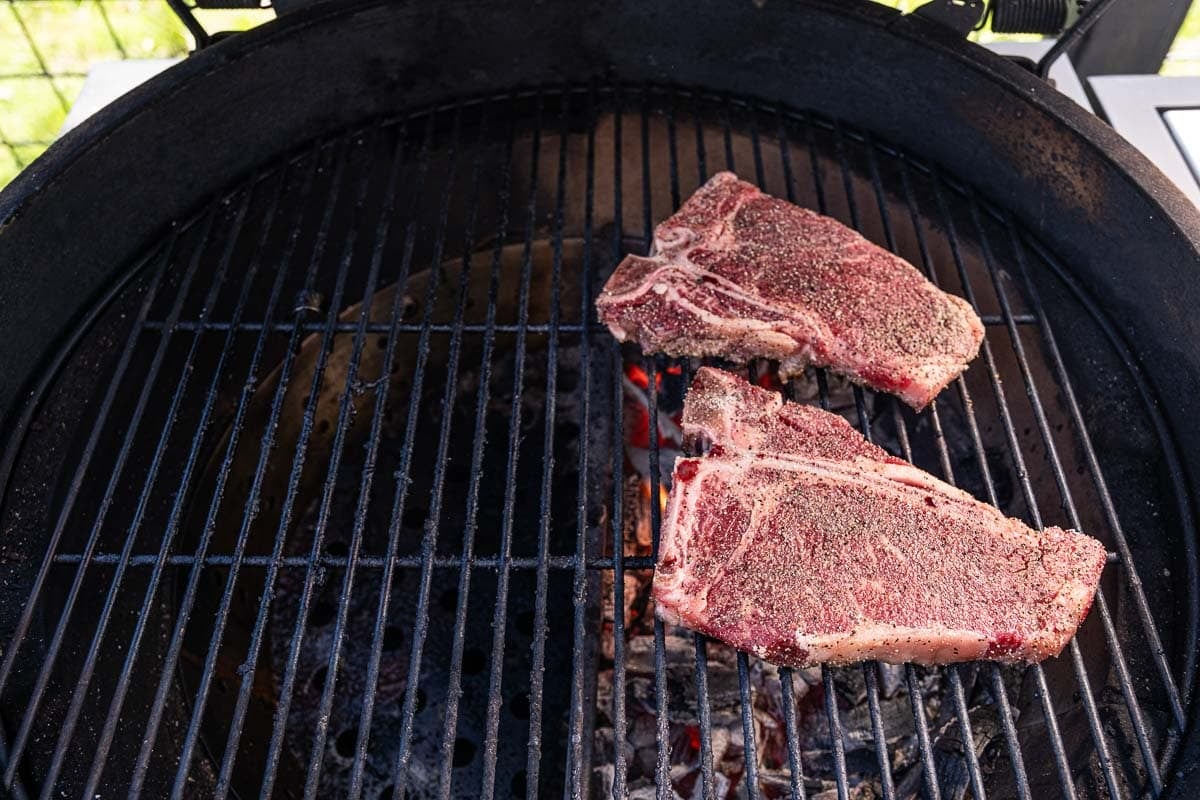
The steaks are grilling over on the direct side, and the indirect side is to help finish the steaks without over-charring them.
- Preheat Grill: Prepare your grill for two-zone grilling, targeting 450 degrees in the cooking chamber. We prefer lump charcoal versus briquettes. Allow the grill grate to get nice and hot.
- Grill Direct: Place the seasoned T-bone steak on the grill grates over direct heat. Don’t walk away. After 2 to 3 minutes, flip and grill on the grates over direct heat an additional 3 minutes. Continue flipping every minute until the steak gets to your desired internal temperature using a good instant-read thermometer like the Thermoworks Thermapen One. We cook to medium rare, which for us is around 130 degrees F.
- Rest: Remove from heat and let rest for 5 minutes to allow for carryover cooking. While it is resting, top with 1 tablespoon of the compound butter. It will slowly melt while the steak rests. Slice and then serve with your favorite sides.
Why 2-Zone Cooking?
If you have a thicker T-bone steak (over 1″ thick), then we recommend finishing it using the indirect side once you have a nice sear. This will prevent charring or burning from the fat drippings.
Thinner steaks will typically cook to your desired temperature over direct heat the whole time, but thicker ones will benefit from moving to indirect after your desired amount of char or crust.
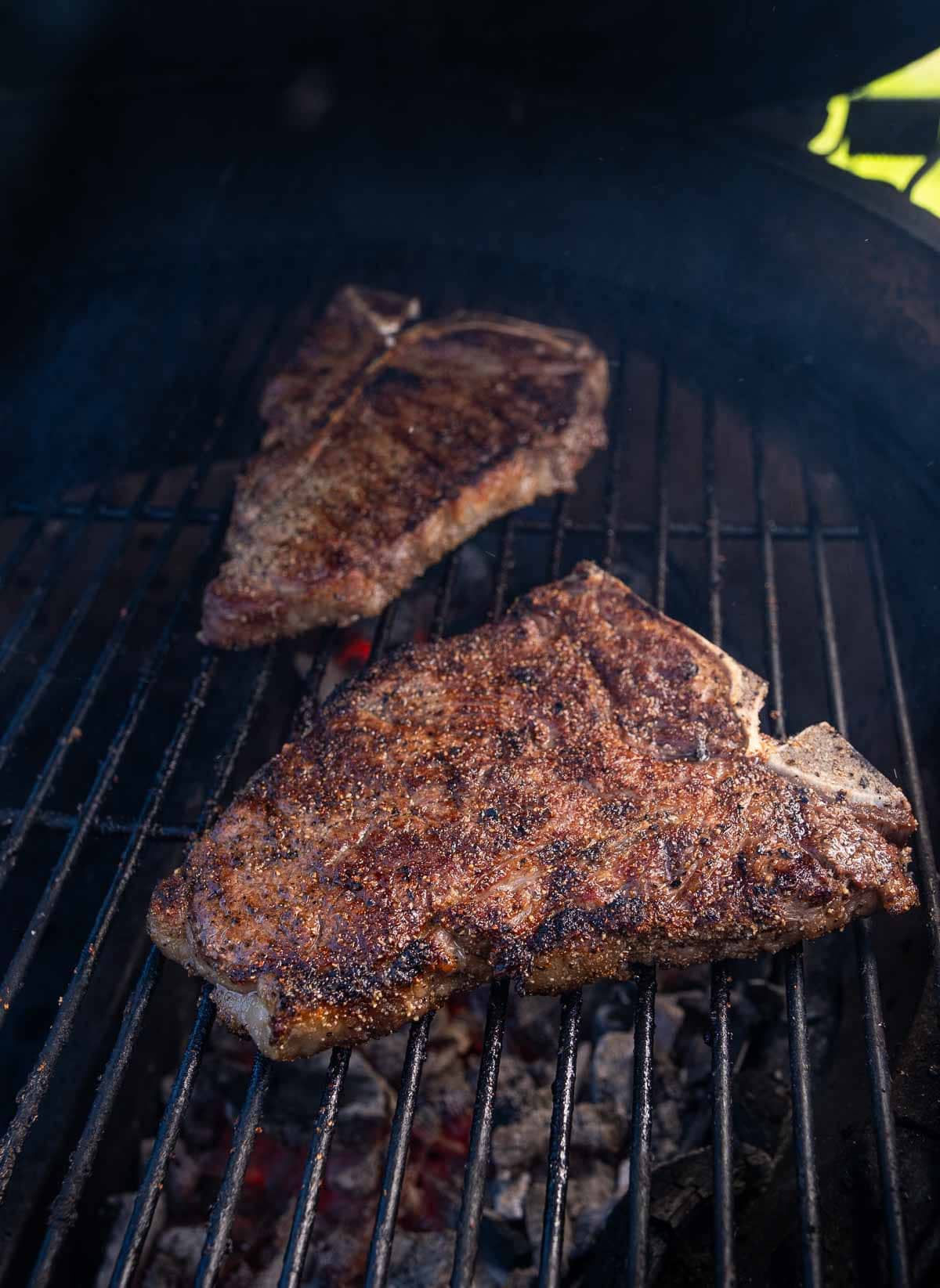
Pitmaster Tip
Always use a meat thermometer to check your temperatures! Guessing can lead to overcooked (or undercooked) steak, especially for thicker cuts like T-bones. A thermometer takes out all the guesswork and makes you look like a pro, even if you’re just getting started.
Frequently Asked Questions (FAQ)
Exact cooking times will depend on the thickness of the steak and the temperature of the grill, but usually 2-3 minutes per side for searing and another 5-10 minutes over indirect heat for medium rare (if needed). Always check with a meat thermometer for best results.
Nope. A T-bone steak shines with simple seasoning. We prefer salt, pepper, and granulated garlic to bring out the natural beefy flavor. The compound butter adds all the extra flavor you’ll need. If you want to marinate, then consider using our Steak Marinade.
Yes! While this recipe is perfect for T-bone steak, you can use the same seasoning and compound butter on ribeye, strip steak, or porterhouse, too.
Beef Temperature Ranges
Be sure to take into consideration the carry-over cooking that happens while the steak rests. For steaks remove them 5 degrees lower than your desired temperature. For roasts remove them 10 degrees lower. The steak’s internal temperature will rise as it rests.
| Black and Blue | 100 – 120° Fahrenheit (F) | 37 – 48° Celsius (C) |
| Rare | 120 – 130° F | 48 – 54° C |
| Medium Rare | 130 – 140° F | 54 – 60° C |
| Medium | 140 – 150° F | 60 – 65° C |
| Medium Well (not recommended) | 150 – 160° F | 65 – 71° C |
| Well Done (not recommended) | 160 – 170° F | 71 – 76° C |
What To Make With This T-Bone Steak
If you want classic, then consider our Restaurant Roasted Potatoes. Crispy on the outside and chewy on the inside. Or consider our Horseradish Mashed Potatoes. If you want a fancy steak frites experience, then use our Grilled Potato Wedges Recipe with a thick-cut russet potato.
Wine Pairing for T-Bone Steaks
Consider a richer, bolder, tannic-forward wine to complement the marbling of the steak. That fat in the steak balances the richer flavor that comes from big wines with lots of tannin. Consider Merlot or Cabernet Sauvignon for reds.
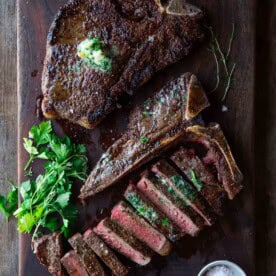
T-Bone Steak With Herb Compound Butter
Equipment
Ingredients
- 2 T-bone steaks (ideally 1 1/2 inches thick), Alternatively you can use a porterhouse steak.
- 2 tablespoons SPG Rub, (If using your own seasoning, avoid any that contain sugar. See notes for more rub ideas.)
Compound Butter
- 4 tablespoons unsalted butter, (room temperature)
- 2 tablespoons chopped fresh parsley
- 1 tablespoon chopped fresh thyme
- 2 clove fresh garlic, grated
- 1 pinch kosher salt (a scant 1/4 teaspoon)
Instructions
- Season: Place the T-bone steaks on a cutting board or sheet tray. Liberally apply seasoning on all sides. Ideally, do this 24 hours prior and store, uncovered, in the refrigerator to dry brine. If you are seasoning just before your grilling, first apply a small amount of olive oil, then the seasoning.
- Preheat Grill: Prepare your grill for two-zone grilling, targeting 450 degrees in the cooking chamber. We prefer lump charcoal versus briquettes. Allow the grill grate to get hot.
- Grill Direct: Place the seasoned T-bone steaks on the grill grates over direct heat. Don’t walk away. After 2 to 3 minutes, flip and grill on the grates over direct heat an additional 2 to 3 minutes. Continue flipping every minute until the steak gets to your desired internal temperature using a good instant-read thermometer like the Thermoworks Thermapen One. We cook to medium rare, which for us is around 130 degrees F.
- Rest: Remove from heat and let rest for 5 minutes to allow for carryover cooking. While the steaks rest, top with 1 tablespoon of the compound butter. It will melt while it rests. Slice and then serve with your favorite sides.
Compound Butter
- Mix everything in a bowl until smooth. You can shape the butter into a log using plastic wrap and chill it if you want to make it in advance. Or just keep it soft and ready to go. As soon as the steaks come off the grill, just spoon about a tablespoon worth onto the top of the steak to melt away. Save any remaining butter in the fridge for another cook!
Notes
- Black and Blue: Under 120°F (under 49°C)
- Rare: 120-130°F (49-54°C) – Rare steak is cooked on the outside but still red on the inside. The meat will be tender and juicy, but it can be more difficult to chew due to its raw center.
- Medium Rare: 130-135°F (54-57°C) – Medium-rare steak has a warm, red center and a slightly firmer texture. Our recommendation.
- Medium: 135-145°F (57-63°C) – Medium steak has a warm, pink center and a firmer texture than medium-rare.
- Medium Well: 145-155°F (63-68°C) – Medium-well steak has a slightly pink center but is mostly cooked through. Not recommended.
- Well Done: 155°F and above (68°C+) – Well-done steak is cooked all the way through and has no pink or red color. Not recommended.
Nutrition
Nutrition information is automatically calculated, so should only be used as an approximation.
